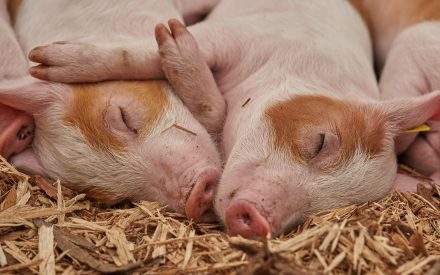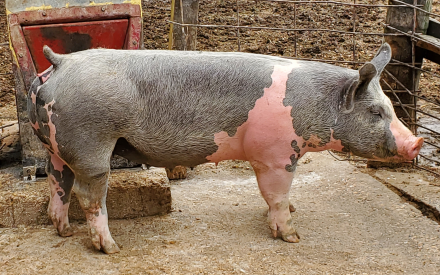Ractopamine-Free Series
Adapted with permission from Ohio State University Extension, “A Ractopamine-Free Swine Project” and “A Ractopamine-Free Swine Project – Primer”
Introduction
Ractopamine-free swine production is now a market specification/requirement throughout much of the U.S. pork packing industry. Ractopamine remains an FDA approved product that can be legally fed in the U.S. at approved levels and approved time periods in the life of a market-destined hog. However, restrictions from trade partners have led to its removal from most production systems. The ability to be ractopamine free opens up export markets for U.S. pork in other countries.
Removal of ractopamine from pork (meat) or pork products (internal organs, blood, fat, etc.) that may enter an export market is paramount. Swine producers, exhibitors, feed industry participants, and transportation participants all must work together to meet market demands.
The pig is the exhibitor’s responsibility and it will need to meet requirements and testing procedures used by packers. Exhibitors should understand the status of any pig they purchase or raise on their farm and comply by not feeding ractopamine.
What is Ractopamine Hydrochloride?
A beta-adrenergic agonist that when fed according to label directions can improve pig growth rate, carcass composition and feed conversation efficiency. Product tradenames include: Paylean® or Engain® for swine, and Optaflexx® or Actogain® and other generic derivatives.
What does Ractopamine-Free Mean?
The pig has never been fed or exposed to ractopamine sources from birth to harvest.
What does this mean for County Fair Management?
Market access for Fair pigs which are sold on open markets may be limited. This generally won’t impact the pigs that go to your local processing plants in towns across Wisconsin; however, if you send to local buying agencies, who then send onward to larger processors, there might be some limitations for market access.
Fair staff need to consider the following
The main and first item that fairs need to do, is to contact your local buying agencies that purchase pigs that don’t go to the local processor. Ask if they have any restrictions on ractopamine and if there are additional requirements such as testing animals.
Ractopamine use should not be an issue for local processors, who receive auction pigs and other fair pigs for carcass shows or direct to consumer sales. Please contact your local processor(s) to make sure they don’t have further requirements that you’re not aware of.
Once fairs have this information they will have a couple of options.
- The buying agency has no requirement related to ractopamine pigs. This is unlikely but possible depending on the buying
- The nature of the fair yields the decision that they need to send pigs to buying agencies (such as Equity…) and there is a requirement that the pigs need to be ractopamine
- The fair isn’t equipped to manage a ractopamine free fair may consider to go non-terminal.
Let’s talk about items to be aware of within each option.
Option 1:
The buying agencies you work with might not have a requirement, related to ractopamine. Their facility and the ability for them to send pigs to secondary markets that don’t have a ractopamine requirement might be available. As mentioned before, this is unlikely but certainly possible.
Option 2:
The buying agency will not take pigs that were fed ractopamine. The fair really needs this market for their fair pigs, thus moves forward with a ractopamine free show.
The fair will require all youth to not feed ractopamine that exhibit at the fair so fairs still have a market. The fair needs to make sure they are clear with the buying station on any additional testing requirement that may be asked of them.
The fair should clean pens, gating and the fair facility where pigs were held in 2019 before the 2020 fair. Make sure that exhibitors are coming to the fair with clean feeders, pans and water containers to avoid residual contamination. Any porous material, penning, gating, fans and fan housings, and residual manure/bedding have a risk for containing ractopamine. Thorough cleaning with a detergent or soap and water, disinfecting, and drying will be necessary.
At the fair, try and arrange ample tack space for feed storage from animals and from each exhibitor’s feed. Observe feed that is brought to the fair to make sure they don’t contain ractopamine.
Fair staff should make every effort to make sure show rings are always clean. Make sure there is a ring steward cleaning behind all animals throughout the duration of a show. Especially if the show ring is being utilized by beef animals that maybe fed Optaflexx® that don’t have a processing plant requirement. Make sure alleyways and wash racks at the fair are cleaned often to remove feces. Even your shoes and boots can be a risk.
Trailers:
Wash, clean, disinfect, and dry transport trailers and vehicles between loads, particularly cattle or any groups, offered ractopamine. When shipping pigs to market facilities don’t share trailers with cattle. As mentioned, cattle maybe fed Optaflexx®, which is ractopamine for cattle feed and can be a point of cross contamination.
Use only fresh shavings (or sand in hot months) as bedding materials as they have no exposure to ractopamine.
Ask the buying agency to clarify identification of pigs going to market. It may be important that pigs be tattooed to follow up on any testing from fair pigs that are done at the processing plant. Corresponding fair tag and tattoo should be recorded.
Ask the buying agency if there will be a requirement of a signed affidavit from a parent or legal guardian stating that pigs under their control have never been offered ractopamine.
Testing for Ractopamine
Packers have the right and the ability to further test pigs upon purchase. There can and will be consequences to exhibitors that weren’t truthful on feeding ractopamine. Tissues that retain ractopamine for a longer duration include the internal organs, muscle, and in the eyes.
Ractopamine, by nature is quickly metabolized in the animal’s system. Depending on the sample (urine, hair, etc.) taken from the live animal it may not indicate ractopamine use but the organ samples might.
Here are some ideas of testing partners if the buying agencies require it or if a fair would like to have some tests on hand. Work with your fair veterinarian and contact these test organizations to work through a protocol ahead of time.
Neogen provides feed, urine and tissue tests.
List of companies that test for ractopamine.
Option 3:
The fair may find that they are not equipped to manage the details of a ractopamine free show. They decide to be a non-terminal show and animals that don’t go through the auction and harvested at local processors can go home. If a fair decides that this is the best decision, please keep in mind the Wisconsin swine health rule now applies. If a fair decides to not manage this new topic of ractopamine free swine and go non-terminal (animals go home), exhibitors will need to make sure they do the necessary testing in order to follow this DATCP legislative state policy.
Exhibitors will need to obtain a test within 90 days of the fair. Please review the following information at: https://bit.ly/3arFlxK
It is important to continue to visit and connect with your buying agencies all summer to make sure requirements haven’t changed. This is a new requirement and companies are still working through how they will manage the situation and how our export markets are receiving this new change.
Reviewed by: Dr. Paul Kuber, Washington State University; Lyssa Seefeldt, UW Madison Division of Extension; Brian Bolan, WI State Fair
Download Article

 Ractopamine Free Swine Project
Ractopamine Free Swine Project Show Pig Nutrition
Show Pig Nutrition


